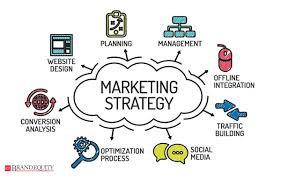Marketing is the dynamic force behind the success of any business. It encompasses a range of activities designed to create awareness, drive sales, and build strong relationships with customers. Whether you’re promoting a product, service, or idea, marketing plays a crucial role in shaping perceptions, influencing decisions, and driving business growth. Here’s an in-depth look at the different aspects of marketing and its evolving landscape.
1. The Fundamentals of Marketing
Marketing is not just about selling products; it’s about understanding customer needs, creating value, and building lasting relationships. At its core, marketing involves four key components, often referred to as the 4 Ps of marketing:
- Product: This is what a business offers to its customers, whether it’s a physical product, a service, or an idea. The product must meet the needs or solve the problems of its target audience.
- Price: The price strategy must reflect the value of the product while being competitive in the market. Businesses must determine the right price point to appeal to their target customers while ensuring profitability.
- Place: This refers to the distribution channels used to deliver the product to customers. Whether through physical stores, e-commerce platforms, or direct sales, place ensures the product is accessible to the right audience.
- Promotion: Promotion encompasses the methods used to communicate the product’s value to potential customers. This includes advertising, public relations, sales promotions, and digital marketing.
2. Digital Marketing and the Shift to Online
In recent years, digital marketing has become a dominant force in the industry. As more consumers shift their attention to the internet, businesses have adapted their marketing strategies to leverage online platforms. Digital marketing includes various strategies such as:
- Search Engine Optimization (SEO): SEO focuses on improving a website’s visibility on search engines like Google. By optimizing content and structure, businesses can drive organic traffic to their site and increase conversions.
- Social Media Marketing: With the rise of platforms like Facebook, Instagram, Twitter, and TikTok, social media has become a powerful marketing tool. Social media marketing enables businesses to engage directly with customers, build brand loyalty, and drive sales through targeted ads.
- Content Marketing: Content marketing is about creating valuable, informative, or entertaining content that resonates with your audience. This can take the form of blogs, videos, infographics, podcasts, and more. The goal is to provide content that engages, educates, and nurtures relationships with customers.
- Email Marketing: Email marketing allows businesses to communicate directly with their audience, providing them with personalized offers, updates, and information. This is one of the most cost-effective marketing strategies that drive high ROI when done correctly.
- Pay-Per-Click Advertising (PPC): PPC campaigns, often run on search engines or social media platforms, allow businesses to target specific keywords or demographics. Advertisers pay only when users click on their ads, making it a highly measurable and results-driven form of marketing.
3. Branding: Building a Connection with Consumers
Branding is one of the most important aspects of marketing. It’s not just about creating a logo or a catchy slogan; it’s about building an emotional connection with customers and establishing a unique identity in the marketplace. Successful branding helps businesses stand out, gain trust, and foster loyalty.
- Brand Identity: This includes elements like logos, color schemes, typography, and the overall design that visually represents a company. Brand identity helps make the company recognizable and memorable to consumers.
- Brand Voice: A company’s brand voice is how it communicates with customers—whether it’s friendly, professional, humorous, or authoritative. The brand voice helps set the tone for customer interactions and conveys the company’s values and personality.
- Customer Experience: The overall experience a customer has with a brand, from the initial point of contact to post-purchase support, is crucial in building a strong brand reputation. A positive experience creates loyal customers who are more likely to recommend the brand to others.
4. Market Research: Understanding Your Audience
Understanding your target market is essential for effective marketing. Market research involves gathering information about consumer preferences, behaviors, and trends to inform decisions and strategies.
- Demographic Research: This includes understanding the age, gender, income level, and other characteristics of your target audience. By knowing who your customers are, you can tailor your messages and products to meet their specific needs.
- Psychographic Research: This focuses on understanding the lifestyle, interests, values, and attitudes of your audience. Psychographic insights allow businesses to create deeper emotional connections with customers by appealing to their motivations and desires.
- Competitive Analysis: Understanding your competitors and their strategies can help you identify opportunities for differentiation and innovation. By studying their strengths and weaknesses, you can find ways to position your product more effectively in the market.
5. Influencer Marketing and Word of Mouth
In the age of social media, influencer marketing has become an essential component of many marketing strategies. Influencers are individuals who have a significant following on platforms like Instagram, YouTube, or TikTok. By partnering with influencers, brands can tap into their audience and gain credibility through authentic recommendations.
- Micro-Influencers: Brands are increasingly turning to micro-influencers—individuals with smaller but highly engaged audiences. These influencers often have more personal and trusted relationships with their followers, making their endorsements more impactful.
- Word of Mouth Marketing: Consumer recommendations and reviews are incredibly powerful in today’s market. Positive word of mouth can spread quickly, particularly on social media and review platforms. Encouraging satisfied customers to share their experiences can drive new business and foster brand loyalty.
6. Marketing Automation: Efficiency and Personalization
Marketing automation involves using software tools to automate repetitive tasks, such as email campaigns, social media posting, and customer segmentation. Automation allows businesses to increase efficiency, reduce human error, and deliver personalized experiences to customers.
- Customer Segmentation: Automation allows businesses to segment their audience based on behavior, demographics, or engagement. By tailoring messages to different customer segments, brands can create more personalized and relevant campaigns.
- Lead Nurturing: Marketing automation can help nurture leads through automated email sequences and follow-ups, guiding potential customers down the sales funnel toward conversion.
7. Analytics and Data-Driven Marketing
In the digital age, data plays a central role in shaping marketing strategies. Marketing analytics tools provide businesses with insights into campaign performance, customer behavior, and ROI. By leveraging data, companies can refine their marketing efforts and make more informed decisions.
- Tracking and Measuring Campaigns: Metrics such as website traffic, click-through rates, and conversion rates provide valuable feedback on how well campaigns are performing. Marketers can adjust their strategies based on this data to improve results.
- Customer Feedback and Sentiment Analysis: Analyzing customer reviews, surveys, and social media mentions helps businesses understand public sentiment and refine their messaging accordingly.
Conclusion
Marketing is a constantly evolving field that requires creativity, strategy, and adaptability. With the rise of digital platforms, the importance of building a strong brand, engaging with customers on a personal level, and leveraging data-driven insights has never been greater. By understanding the fundamentals of marketing and staying ahead of trends, businesses can continue to thrive in an increasingly competitive landscape.

